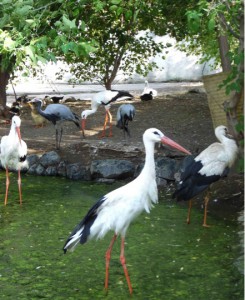
The four stork nestlings at the Yerevan Zoo with cranes, a swan, and ducks. In August the storks will be returned to the Ararat Plain.
More than a year after the completion of its White Storks Project, the AUA Acopian Center for the Environment (AUA ACE) continues to receive calls for support from villagers in the Ararat Plain seeking advice on how to care for stork chicks that are displaced or injured from natural or human causes.
From the start of the the current breeding season in early Spring to date, AUA ACE’s logs show 37 such calls. More than half of these callers received advice on how to handle the emergency and care for the nestlings—young storks yet unable to fly. For the remainder, the AUA Acopian Center for the Environment sent a vehicle to the villages to provide either veterinarian care on the spot or to bring the nestlings to Yerevan for care.
To date, 13 nestlings were transferred to Yerevan to be placed under special care. Eight of these have survived. The injuries of the others were too severe, making their survival impossible with the wildlife rehabilitation capabilities available in Armenia.
In one instance, AUA ACE sought the help of the Yerevan Zoo for four nestlings that were thrown out of their nests during strong winds in the Ranchpar and Apaga villages. “Such an incident, under natural conditions, eliminates the nestlings’ chances of survival. If they are not in their nests, their mothers stop caring for them,” says AUA ACE Chief Scientist Dr. Karen Aghababyan. According to him, it is best to return the nestlings to their nests immediately. But this is not always possible as necessary equipment may not be readily available. “When this happens [i.e., too much time passes] the mother may reject the nestlings if returned to the nest,” explains Dr. Aghababyan.
The concerned villagers cared for these four storks and then called AUA ACE for advice. As too much time had gone by, AUA ACE sent a vehicle to the villages to transfer the birds to the Yerevan Zoo.
“We are happy to serve as a transitory home for these four orphaned stork nestlings that hopefully will soon rejoin their flock,” say Ruben Khachatryan, director of the Zoo.
The storks will stay at the Zoo until they learn to fly and hunt, which is expected to happen in the coming month. While their ability to fly will develop naturally, their hunting skills require learning. “Their hunting skills will be tested at the Zoo. They will also have additional occasions to learn from other storks back in the Ararat Plain in August,” explains Dr. Aghabayan.
He adds that while the Acopian Center for the Environment typically does not want to intervene in the natural processes affecting stork populations, “there are many instances where the birds are injured as a result of man made environments, such as electrical wires, pesticides in water, and the like.” He stresses that AUA ACE’s efforts to save the storks is a small compensation for all the instances where we humans cause harm to the stork population. “Also it provides a great educational opportunity for the communities involved,” concludes Dr. Aghababyan.

Comments are closed, but trackbacks and pingbacks are open.